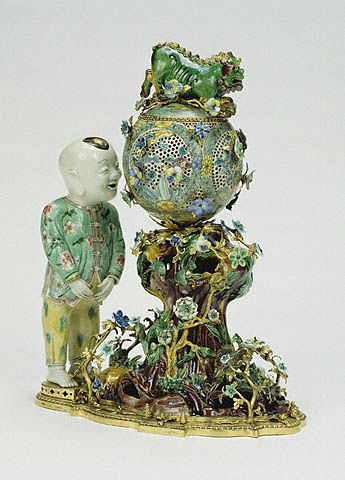Pair of Decorative GroupsPair of Decorative Groups. Unknown. Porcelain: Chinese, 1622-1795; Flowers & mounts: French, 1740-45
Pair of Decorative Groups. Unknown. Porcelain: Chinese, 1622-1795; Flowers & mounts: French, 1740-45. Hard and soft-paste porcelain, polychrome enamel decoration; gilt bronze mounts. 78.DI.4. The J. Paul Getty Museum ©J. Paul Getty Trust
French craftsmen combined diverse pieces of Chinese porcelain in an inventive arrangement to create these decorative groups. The two boys, originally freestanding porcelain sculptures, were known as the Immortal Twins; they were the patrons of Chinese potters and merchants. The so-called fo dogs are in fact Buddhist lions. These porcelain lions were originally fixed to the top of the porcelain rocks but are now separated by pierced porcelain spheres. The globe-shaped balls were used in China as pomanders, filled with flowers or solid balls of perfume.
A Parisian marchand-mercier would have purchased the figures, the lions mounted on the rocks, and the spheres; he then directed French craftsmen to make a gilt bronze base cast with small lizards, snails, and shells. To establish a connection between the different parts, he directed the workmen to place the boys so that they seem to peer into the perfume balls; he added French porcelain flowers on gilt bronze branches to further adorn the design.
The original French owner of the groups would have appreciated the exotic decorations but would probably not have recognized their original Chinese function or significance.

/https%3A%2F%2Fprofilepics.canalblog.com%2Fprofilepics%2F1%2F0%2F100183.jpg)
/https%3A%2F%2Fstorage.canalblog.com%2F03%2F02%2F119589%2F96711876_o.jpg)
/https%3A%2F%2Fstorage.canalblog.com%2F11%2F31%2F119589%2F94773502_o.jpg)
/https%3A%2F%2Fstorage.canalblog.com%2F20%2F83%2F119589%2F94772815_o.jpg)
/https%3A%2F%2Fstorage.canalblog.com%2F26%2F72%2F119589%2F75604929_o.jpg)
/https%3A%2F%2Fstorage.canalblog.com%2F59%2F60%2F119589%2F26458628_o.jpg)



/http%3A%2F%2Fstorage.canalblog.com%2F82%2F68%2F119589%2F110533545_o.jpg)
/http%3A%2F%2Fstorage.canalblog.com%2F69%2F30%2F119589%2F110533471_o.jpg)
/http%3A%2F%2Fstorage.canalblog.com%2F03%2F44%2F119589%2F110533387_o.jpg)
/http%3A%2F%2Fstorage.canalblog.com%2F01%2F75%2F119589%2F110533260_o.jpg)